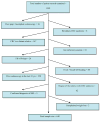Prevalence of any size adenomas and advanced adenomas in 40- to 49-year-old individuals undergoing screening colonoscopy because of a family history of colorectal carcinoma in a first-degree relative
- PMID: 21514930
- PMCID: PMC3514447
- DOI: 10.1016/j.gie.2011.02.010
Prevalence of any size adenomas and advanced adenomas in 40- to 49-year-old individuals undergoing screening colonoscopy because of a family history of colorectal carcinoma in a first-degree relative
Abstract
Background: Per current guidelines, patients with a first-degree relative (FDR) with colorectal cancer (CRC) should get screened at least at age 40. Data about the prevalence of adenomas and advanced adenomas (AAs) in these patients are lacking.
Objective: To examine the prevalence of adenomas and AAs in 40- to 49-year-old individuals undergoing screening colonoscopy for family history of CRC.
Design: Retrospective chart review.
Patients: Asymptomatic patients 40 to 49 years of age undergoing their first screening colonoscopy at the University of Michigan during the period 1999 to 2009 because of an FDR with CRC.
Main outcome measurements: Prevalence of adenomas (any size), AAs, and risk factors associated with adenomas.
Results: Among 640 study patients, the prevalence of adenomas (any size) was 15.4% and 3.3% for AAs. Adenoma prevalence was lower if the FDR with CRC was younger than 60 years of age versus an FDR with CRC older than 60 years of age (12.4% vs 19%, P = .034). Male sex (odds ratio 2.6; 95% CI, 1.06-4.4) and advancing age (odds ratio 1.16; 95% CI, 1.03-1.31) were associated with adenomas.
Limitations: Limited data on risk factor exposure and insufficient sample size to assess risk factors for AAs.
Conclusions: Among 40- to 49-year-old patients undergoing screening colonoscopy because of an FDR with CRC, the prevalence of adenomas and AAs is low. Further research should determine whether these individuals have a higher prevalence of adenomas compared with average-risk individuals.
Copyright © 2011 American Society for Gastrointestinal Endoscopy. Published by Mosby, Inc. All rights reserved.
Figures
Comment in
-
Colonoscopic yields in 40- to 49-year-old patients with a history of colorectal cancer in a first-degree relative: how high is the risk?Gastrointest Endosc. 2011 Jul;74(1):119-21. doi: 10.1016/j.gie.2011.03.1232. Gastrointest Endosc. 2011. PMID: 21704810 No abstract available.
References
-
- Butterworth AS, Higgins JP, Pharoah P. Relative and absolute risk of colorectal cancer for individuals with a family history: a meta-analysis. Eur J Cancer. 2006 Jan;42(2):216–27. - PubMed
-
- Levin B, Lieberman DA, McFarland B, Smith RA, Brooks D, Andrews KS, et al. Screening and surveillance for the early detection of colorectal cancer and adenomatous polyps, 2008: a joint guideline from the American Cancer Society, the US Multi-Society Task Force on Colorectal Cancer, and the American College of Radiology. CA Cancer J Clin. 2008 May-Jun;58(3):130–60. - PubMed
-
- Fuchs CS, Giovannucci EL, Colditz GA, Hunter DJ, Speizer FE, Willett WC. A prospective study of family history and the risk of colorectal cancer. N Engl J Med. 1994 Dec 22;331(25):1669–74. - PubMed
-
- Rex DK, Johnson DA, Anderson JC, Schoenfeld PS, Burke CA, Inadomi JM. American College of Gastroenterology guidelines for colorectal cancer screening 2009 [corrected] Am J Gastroenterol. 2009 Mar;104(3):739–50. - PubMed
-
- Guillem JG, Forde KA, Treat MR, Neugut AI, O’Toole KM, Diamond BE. Colonoscopic screening for neoplasms in asymptomatic first-degree relatives of colon cancer patients. A controlled, prospective study. Dis Colon Rectum. 1992 Jun;35(6):523–9. - PubMed
Publication types
MeSH terms
Grants and funding
LinkOut - more resources
Full Text Sources
Medical


